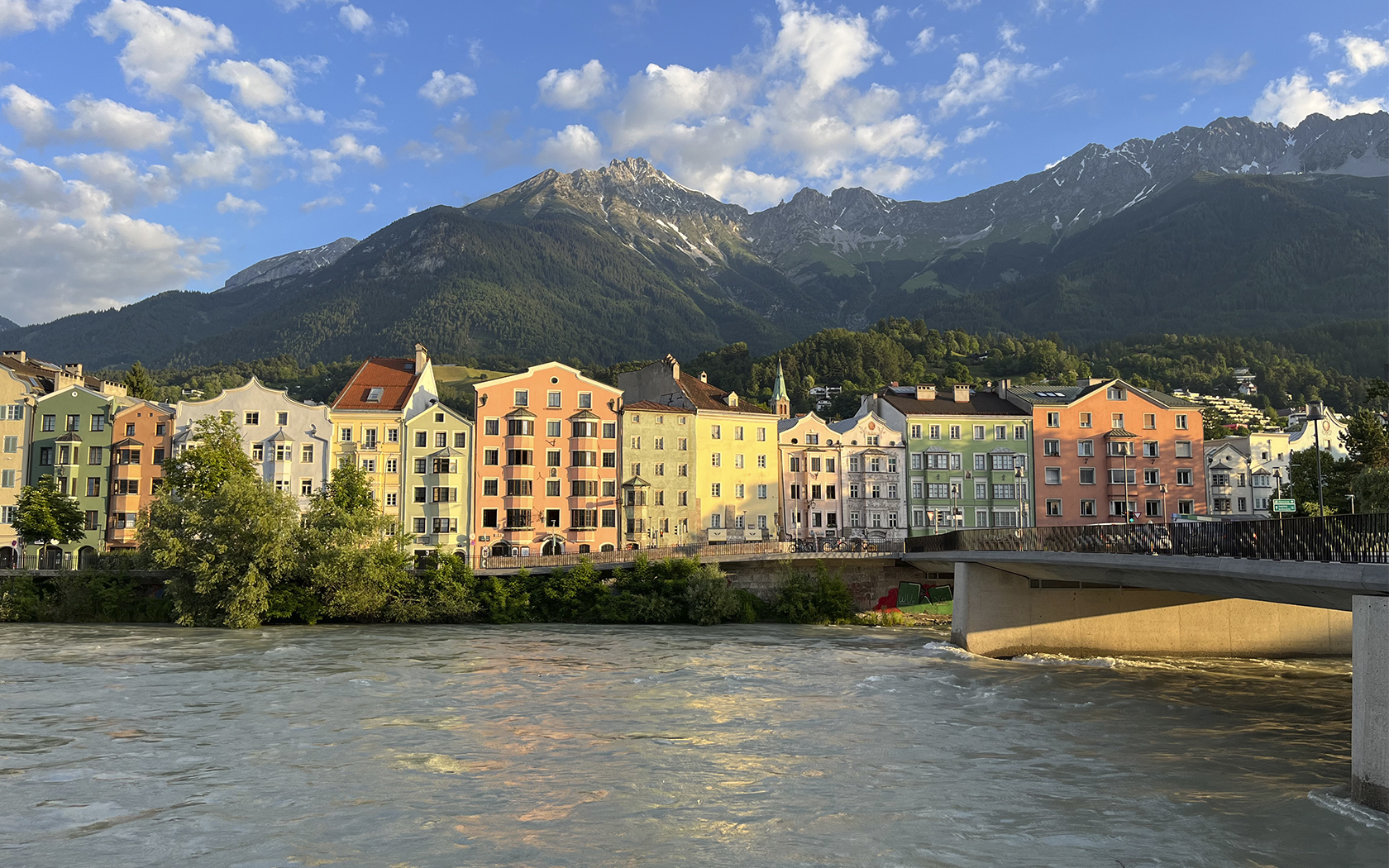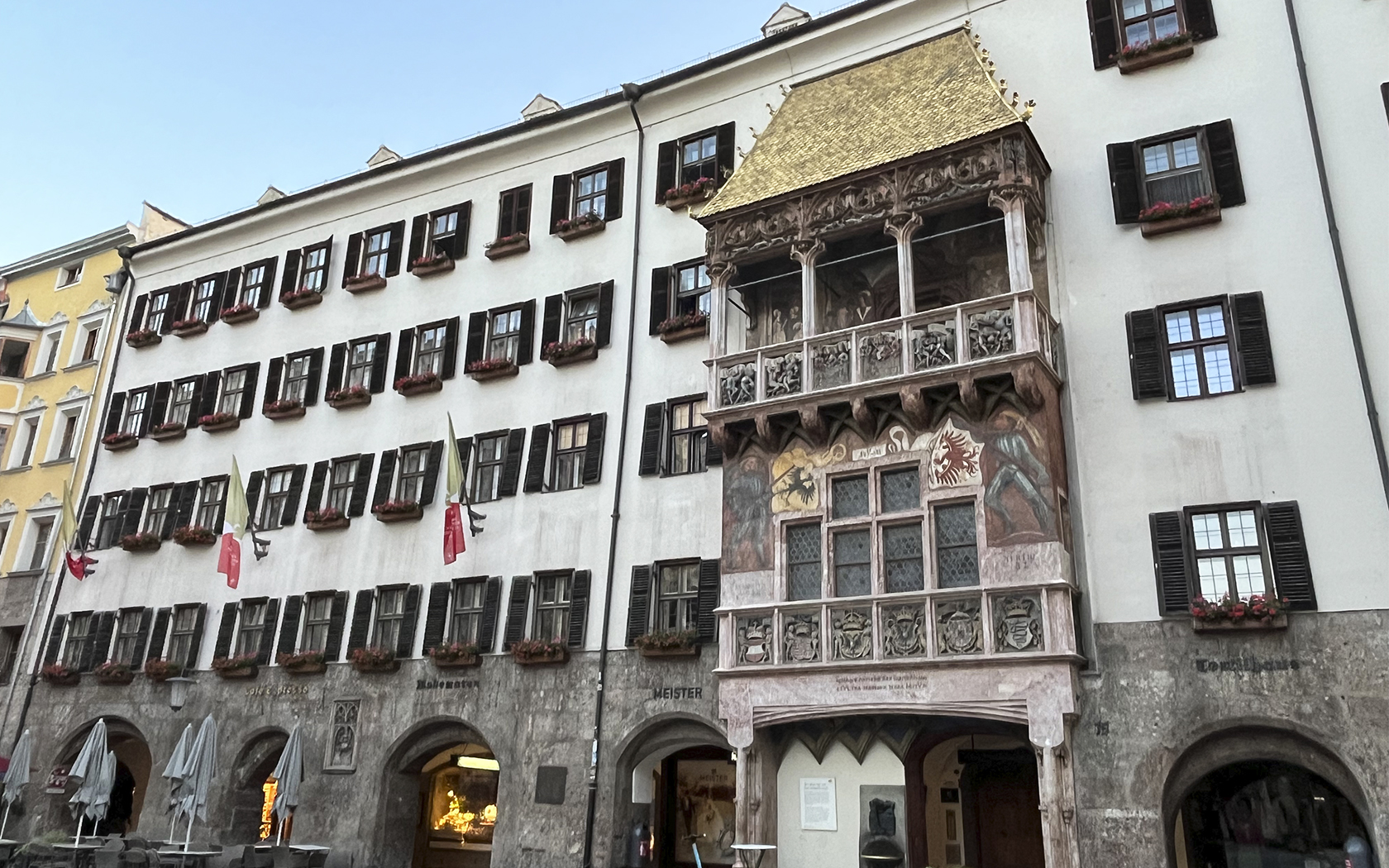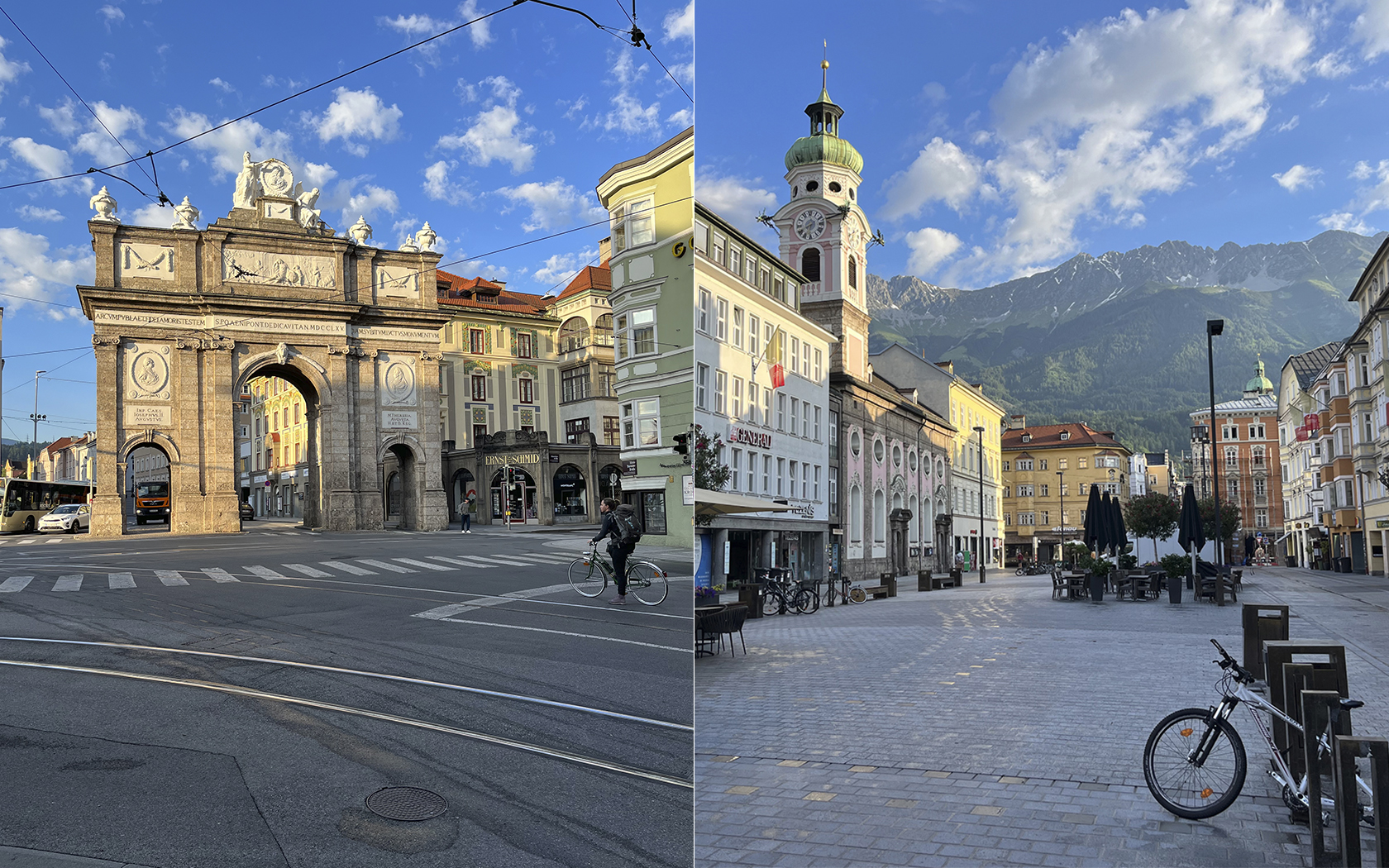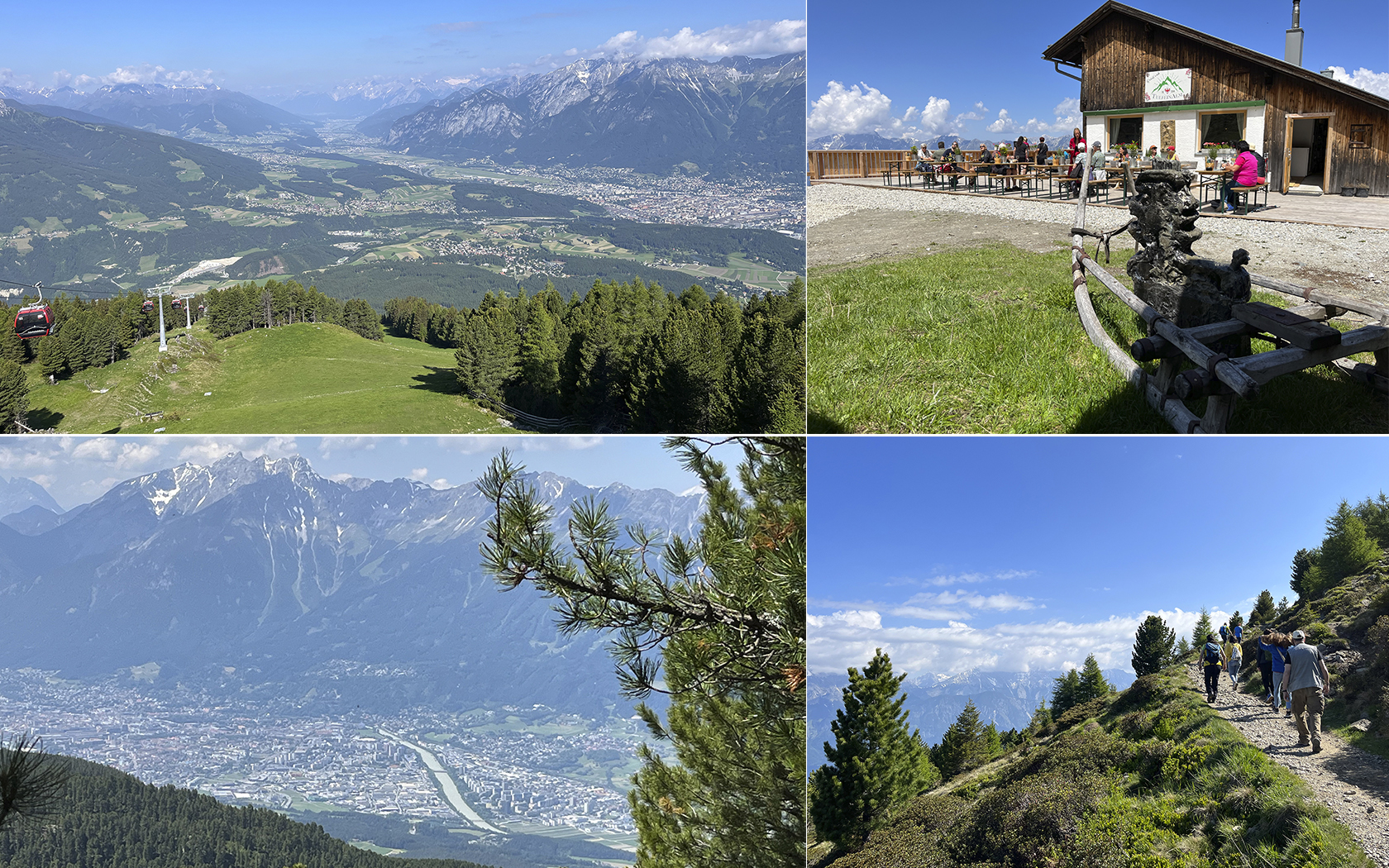Located in the heart of the Alps, Innsbruck is a city of dreams, the alpine jewel of Tyrol known as an ideal destination for sports, historic architecture and picturesque houses reflected in the Inn River with the majestic backdrop of the Tyrolean Alps in the background.

Innsbruck at dawn
If you’re thinking of a getaway, Innsbruck (Inn=name of the river and brücke=bridge in German) is one of the most beautiful alpine and urban destinations in Tyrol for its spectacular mountains, rich history, cultural offerings and city life. Here are some tips you won’t be able to resist.


The city of Innsbruck and its places of interest to visit
1-A stroll through the squares and narrow streets of the old town (Altstadt) full of museums, shops, cafés and restaurants.
We start with a stroll through the picturesque pedestrian streets of the historic centre (Altstadt) to enjoy the alpine atmosphere where you can discover its medieval past whose construction began in the 12th century.
In the city centre square is one of the most representative symbols of the city: the Golden Roof (Das Goldene Dach), a 15th-century box that Emperor Maximilian I had built in 1494 for his second wife Bianca Maria Sforza. It is covered with 2,657 fire-gilded copper tiles and has a balcony with frescoes of Emperor Maximilian I and reliefs.

Tejadillo de Oro is a symbol of late Gothic architecture.
Today it houses the Museum of the Golden Roof where the life of Emperor Maximilian I and his wife Bianca Maria Sforza as well as information about the building and its symbology are exhibited. Located at 15 Herzog-Friedrich-Strave square.
Directly opposite is the House of Helbling, an architecturally emblematic building with one of the most impressive façades in the city where we can see a mixture of Gothic and Baroque elements. Built in the 15th century, but renovated and extended in the 18th century by the architect Anton Gigl.

Helbing House
On the same square is the Clock Tower(Sadtturm) built in the mid-15th century as a watchtower to warn of enemies and fires, while the lower floors served as a prison.
After climbing 133 steps of spiral staircase you reach the viewing platform with spectacular 360-degree panoramic views of the city. Here you can see a unique perspective of the city and its history.

Left. Clock tower. Right. 360º views from the lookout point of the tower.
The red house next to the tower was formerly the town hall and is today the Tourist Office of the city of Innsbruck.
- Address of the Stadtturm tower: Herzog-Friedrich-Straße 21, Innsbruck, Austria.
A few minutes’ walk from the Altstadt brings us to The Court Church (Hofkirche) which houses the funeral monument of Maximilian I.
Ferdinand II had this church built by his great-grandfather, Emperor Maximilian I, in the mid-16th century. Upon entering, you will find 28 life-size bronze figures standing guard before the mausoleum of Emperor Maximilian I, which is empty, being the chapel in Wiener Neustadt (45 km from Vienna) where he is buried.

Left: Ferdinand II ‘the Catholic’ with his daughter Juana of Castile or ‘Juana the Mad’. Right the empty mausoleum of Maximilian I surrounded by the 28 bronze figures with the Renaissance organ in the background.
The statues surrounding the cenotaph depict members of his family and historical figures who were outstanding in their exploits, European rulers and heroes.
This church also houses the tomb of the Tyrolean hero Andreas Hofer, who fought against Napoleon Bonaparte’s forces in 1809.
Address Court Church: Universitätsstrave 2
Opposite the Court Church is the HofburgImperial Palace, built in 1460 on behalf of Archduke Sigismund of Austria. It was completed during the reign of Emperor Maxilian I (father of Philip the Handsome), but almost 250 years later, at the end of the 18th century, Empress Maria Theresa commissioned the renovation of the building in a Viennese Baroque design that can be seen today.

Imperial Palace
A palace that was the residence of the Habsburg monarchy, one of the most influential royal houses in Europe.
Inside, it houses the luxurious imperial flats with period furnishings, two chapels, the Tower of the Coats of Arms, and the three representative halls which show the history of the Habsburg and Austrian monarchy. In summer, classical music concerts are held in the courtyard of the imperial palace.
The Arc of Triumph (Triumphforte) is about 15 minutes walk from the Imperial Palace and can be reached by taking Maria-Theresien-Strasse, one of Innsbruck’s main shopping and pedestrian streets with the famous St. Anne’s Column from 1703.

Right Triumphal Arch and left Maria-Theresien-Straße with the St. Anne’s Column. Photos taken at dawn with the first rays of the sun.
Innsbruck’s craftsmanship is written in capital letters.
The Norz jewellery shop, where Christoph Norz, sixth generation goldsmith, runs the shop on Innsbruck’s main street, renowned for working with precious and high-quality materials
.
The workshop upstairs, the master craftsmen create individual and unique jewellery, where his son Julius Norz, the seventh generation, is located.

Christoph Norz and his son Julius in the shop on Maria-Theresien-Straße
In the old town you will find Stastny-bürsten, a small shop that started in 1886 as a brush workshop. Today there is a universe of brushes and bits of all kinds: for hair, body, shaving, shoes, clothes, carpets, bath and much more.
All of the old town can be visited on foot, enriching the experience and connecting you in a more authentic way to the city where you can organise your time and route even so, we recommend hiring a private guide like @verena_staudinger she is an excellent city guide where she explains the history of the streets, buildings and museums as well as mountain guide where she takes you on hikes giving information about the flora and fauna of the Tyrol region.
2-Gastronomic tour with Kurt: the guide who introduces us to the local products of the region
Kurt is the gastronomic guide par excellence. We start our tour at the local market Markthalle where he introduces us to the most typical Tyrolean products: Almkäse (Alpine cheese), Tiroler Bergkäse (Tyrolean mountain cheese), Tiroler Graukäse (Tyrolean grey cheese), Cembro Zirbe pine liqueur or Migenzuckerlen digestive sweets made of cinnamon, cloves and sugar. The Tyrol is also a major producer of potatoes and apples.
Kurt tells us:
For me, a gastronomy tour means learning about the country. This way we get to know the local products of the Tyrol region.
We continue the route visiting Der Altstadtbäck Kröll, the oldest bakery in the city where we taste the different breads. There are breads in the shape of a mouse, which for the inhabitants of Tyrol is a symbol of good luck.

The cafe Munding, founded in 1803, is the oldest cafe in Tyrol and the first to introduce a terrace in Innsbruck. Today it is run by the 6th generation and inside you can see coffee machines dating back to 1961 or 1930. It has an exquisite selection of cakes and they roast the coffee themselves. They offer chocolate bombs to melt with hot milk, a delicious snack that you can enjoy at any time of the day.

Left: Cafe Mondo. The photos on the right belong to the hotel Weisses Rossl.
The next stop is the Restaurant Weisses Rossl in a cosy room with a small wine cellar and a carpenter’s table. Here typical Tyrolean dishes include Gröstl (potato, onion and meat), Schlutzkrapfen (like spinach stuffed radishes with cheese and butter), Pressknödel (pressed dumplings) or the famous Tyrolean apple strudel.
From here, we continue with a walk to Coffeekult a space that after 15 years, has become a coffee reference. You can enjoy a coffee with typical Tyrolean pastries.
The tour with Kurt is 2, 4 or 6 hours and you can choose the one that suits you best. Language: English.
3-The city that connects mountain and sport in just 20 minutes from the centre.
For sport and nature lovers, in summer, there are numerous activities such as hiking, climbing and cycling.
From Innsbruck Congress station, the Nordkettenbahnen (north of the city) funicular, designed by Iraqi architect Zaha Hadid in 2007, departs. After three stops you’ll reach the top of the Nordkette mountain range, where you can recharge your batteries at Hafelekar Mountain, a restaurant offering breathtaking panoramic views of the Alps and the city of Innsbruck. You can also enjoy food and drinks with local produce at an altitude of 2,256 metres.

Views from the top of Nordkette
The Nordkette mountain range is part of the Karwendel Nature Park, considered the largest in Austria.
To climb Patscherkofel Mountain (2,246m) you have to go to Igls, which is about 5km south of Innsbruck. The initial ascent and the final descent are made by a gondola lift. Once there you take a path and start a hike through flowers, birch forests and alpine larches.
Aftera two and a half hour walk, at the top of the mountain, we find the Tulfein Alm hut, which is a restaurant offering local dishes at 2035m with excellent views of the Inntal valley, as well as a place to rest.

Zirbenweg trail, a stage of the “Adlerweg’ at 400 m. and the Tulfeinalm hut
Verena, our private mountain guide, ordered the traditional dishes such as meatballs with cheese and spinach or smoked ham and meatball with mushrooms.
Without a doubt, it is the perfect getaway for sports, enjoying traditional food and marvellous views. A place that invites contemplation and tranquillity..
The alpine zoo, where the Hungerburgbahn makes a special stop and is the highest with more than 150 species and about 2000 animals living in the Alps. It is unique in Europe.
4-The green giant on the hill of the Swarovski crystal museum
In 1895 Daniel Swarovski founded his cut crystal company in Wattens and in 1995, on the occasion of the centenary, he commissioned the versatile Austrian artist André Heller to create the Swarovski Crystal Worlds.
The result was a landscape project accompanied by an immersive experiential space for great artists such as Yayoi Kusama, Manish Arora, James Turrell, Tord Boontje, Lee Bul, Brian Eno, André Heller, to interpret glass from their point of view.

Elton John in ‘The Art of Performance’ is the name of the exhibition created by designer Michael Schmidt and set designer Derek McLane featuring the Hollywood artist’s accessories and dresses created with Swarovski.
The entrance of the museum represents the head of a 17-metre high giant with a waterfall and inside it houses the 18 chambers of wonders. And why a giant? Because the giant protects each of the treasures inside. Today it is a Swarovski icon and one of the most visited attractions in the Tyrol region.

Entrance to the Swarovski Crystal Worlds
Outside there is a garden with impressive art installations such as the Crystal Mist with more than 800,000 crystals by the designers CAO PERROT or the Carrousel in black and white by the Spanish artist Jaime Hayon, a masterpiece consisting of 15 abstract figures representing animals. The 17,000 Swarovski crystals on the merry-go-round contrast with the green Tyrolean landscape.
5- Ambras Castle
This castle is famous for its impressive collection of art and historical objects collected by Archduke Ferdinand II. From armour, portraits, musical instruments, rare books and curiosities.

Castillo de Ambras
The castle is divided into three parts: the lower section which houses the art collection and the upper section which houses the residential rooms and the “Chamber of Art and Curiosities” considered the first collection of “kunst- und Wunderkammer” art. In addition to the first ballroom, the so-called Spanish Hall and the palace on high.
This museum offers a detailed look at the historic art collection and objects of the Austrian nobility.
6-Tyrol Panorama
The Tyrol Panorama museum houses all kinds of objects, animals and plants that are part of the history and cultural heritage of the Tyrol. It is also a tribute to the Tyrolean Imperial Hunter Regiment, an elite unit of the Austrian army, which took part in the First and Second World Wars.
In addition, in the same museum there is a room with a giant panoramic painting of 1000m2 depicting the Third Battle of Bergisel during the Tyrolean Wars of Liberation in 1809.

Verena during the explanation of the painting
The painting has a diameter of 26 metres and a height of 10 metres and is 100m long, creating a three-dimensional illusion.
The Tyrolean Panorama Restaurant combines traditional Tyrolean cuisine such as Wiener Schnitzel, Spätzle and apple strudel with stunning views of the Inn Valley, so it can be a good time to stop, eat and look out over the town from one of its two terraces.
Highlights:
-You can drink tap water that comes from the Alps and is crystal clear spring water.
-The three products protected by the European Union: milk, cheese and speck.
If you buy the Innsbruck Card you can get free transport and entrance to all museums and climb the mountains around Innsbruck.
-The Innsbruck coat of arms symbolises the bridge over the river Inn but seen from a bird’s eye view.
– On Mondays and Wednesdays during the months of June and July there is a 20 km walk. On scooters and roller skates.
-In August there is an early music festival.
-Most shelters do not accept credit cards and it is only possible to pay in cash.
– New Orleans Festival Jazz during the month of June.
-During the month of June, there are many sporting events; running, climbing, cycling…
Recommended restaurants:
-Restaurant Ottoburg has the typical facade of a Tyrolean house.
-Restaurant Patscherkofelbahn mountain hut at the foot of the slopes.
-Speckeria offering smoked charcuterie boards and meat pies with wines and beers.
-Restaurant 1809 located in the Tyrol Panorama museum, with views of Innsbruck and good Austrian cuisine.
This alpine town offers a diversity of cultural, historical and sporting activities and is the perfect place to escape to at any time of the year.




